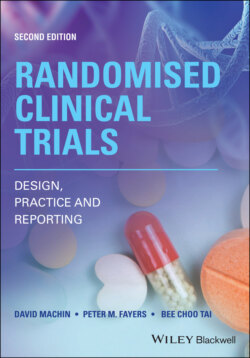Читать книгу Randomised Clinical Trials - David Machin - Страница 20
Example 1.6 Non‐inferiority trial – uncomplicated falciparum malaria
ОглавлениеZongo, Dorsey, Rouamba, et al. (2007) conducted a randomised non‐inferiority trial to test the hypothesis that the risk of recurrent parasitaemia was not significantly worse with artemether–lumefantrine (AL) than with amodiaquine plus sulfadoxine–pyrimethamine (AQ + SP). A total of 826 patients were screened of which 548 were found to have uncomplicated malaria and were randomised (273 to AQ + SP and 275 to AL). A primary endpoint was the risk of treatment failure within 28 days of randomisation. The authors concluded that AQ + SP, with a recurrent malaria rate of 1.7% (4/233), was more effective than AL, with a rate of 10.2% (25/245) and representing a difference of 8.5% (95% CI 4.3–12.6%). These results suggest that the hypothesis of ‘non‐inferiority’ should not be accepted as the CI included the non‐inferiority limit of 3% set by the investigators.
Key features include the following:
Design: Multicentre, two‐group, non‐inferiority trial,
Endpoint: Time to recurrent malaria,
Size: Large – 548 patients with uncomplicated falciparum malaria,
Analysis: Comparison of Kaplan–Meier survival curves,
Conclusion: AL was less effective than (inferior to) AQ + SP.
